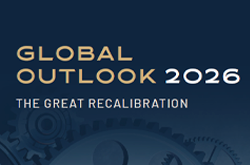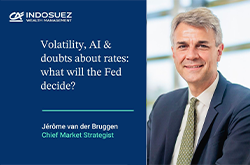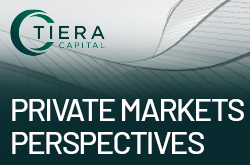Ain’t no mountain high enough?
Christine Lagarde’s Sintra speech end of June echoed to Marvin Gaye’s 1960s tune. And yet, not all central banks are destined to copy the Bank of Canada’s stop-and-go hikes. As for our scenario, while we recognise this "higher for longer" rate risk, we do not buy a scenario in which the Federal Reserve (Fed) resumes a cycle of multiple rate hikes and give our preference to the "high for longer" mantra. Neither our central scenario nor the alternative risk scenario invites us to take a positive view on duration for the time being.
For several months, the markets had thought they were heading slowly but surely towards the end of one of the most intense and rapid monetary tightening of recent decades. At a time when the bulk of the tightening has been completed, we have two main observations to make:
- After months of debate about the long-awaited recession in the US, it has still not materialised and analysts are continuing to postpone their recession forecasts.
- The US equity market corrected in 2022 but since has returned to the levels that prevailed before the start of the Fed's tightening cycle.
Data dependency: the post-COVID paradigm
These dynamics raise questions about the real perception of this tightening, which seems to be well underway: US real interest rates are hovering at 1.5% (a level that can be considered restrictive for the economy), money creation has been contracting for several months, and lending conditions are tightening (even more so since the emergence of banking stress in March). However, the US economy is resilient, inflation, although decelerating, remains at high levels and the labour market is more resilient than ever.
The particularity of this inflation cycle lies in the supply and demand imbalances that resulted from the pandemic, leading to record levels of inflation not seen (by far) since the early 1980s. These specific dynamics complicate the task of central bankers in their estimates of the growth and inflation environment, which partly explains the 'data dependent' approach that central banks have been adopting for several months now. It also justifies their willingness to opt for 'pauses' in the tightening cycle in order to measure the real impact of monetary policy on the economy.
The Hawks are out
In the narrative of recent months, a pause by the central bank was interpreted as the end of the normalisation cycle, given the rate cuts anticipated by the markets following a pause.
However, the decision by the Australian and Canadian central banks to raise their rates after a pause has brought back to the fore front the risk of a more hawkish Fed than anticipated by the markets. The latter still saw a terminal rate at 3.8% (mid-March) at the end of 2023 (the Fed's projections are now at 5.6%). The wave of hawkishness has returned to the markets. The Bank of England (BOE) decided last week to perpetuate this trend by raising its key rates by 50 basis points (bps) (25 more than expected). The markets are now expecting more than 100 bps of rate hikes between now and the end of the year. Though the UK is experiencing tougher inflation dynamics, with core inflation still on an upward slope (+7.1% on the Core CPI in May, compared with 5.8% at the start of the year) and wage growth not stabilizing (jumping from 5.8% in March to 6.5% in May) justifying in our sense a BoE hawkish stance.
On the other hand, we are less worried about Europe, where the disinflation phenomenon seems to be well and truly underway. We expect weaker growth in Europe in the months ahead (and the recent subdued PMI are confirming this view) while wage inflation seems less pressing on the old continent, and credit conditions continue to deteriorate, despite the European Central Bank having begun its tightening after the Fed and the BoE. In our view, this delay justifies two further rate hikes, which would take the terminal rate to 4%.
At present, only Japan is escaping this wave of hawkishness. Against a backdrop of historically high inflation in Japan the Bank of Japan's (BoJ) monetary policy clearly appears to be at a crossroads, particularly in view of the yield curve control still in place. Especially as the contrast between Japan's monetary policy and the hawkish approach of other central banks continues to weigh on the yen at a time when more and more officials are beginning to worry about the weakness of the Japanese currency. So far, BoJ’s governor Kazuo Ueda appears to be in no rush to review the current policy.
We believe in the High (not higher) for longer mantra
Back in the spotlight again, the risk of higher rates inevitably raises questions about the course the Fed should take in the months ahead. In recent months, the rigidity of core inflation and the resilience of the US labour market have already prompted the market to revise upwards its rate expectations by more than 150 bps (since midMarch), moving closer to the plateau scenario that we have been highlighting since the start of the year. The Fed did not raise rates in June, but it has clearly returned to a "Wait & See" approach, with a decidedly hawkish bias in view of its projections, which imply 50 bps of further rate hikes between now and the end of 2023, an upward revision of US growth (from 0.4% to 1% Q4 2022/Q4 2023) and a core inflation rate of 3.9% in December 2023.
In terms of our scenario, although we are taking account of this "higher for longer" rates risk, we are not buying a scenario in which the Fed resumes a cycle of several rate hikes and give our preference to “high for longer” mantra. Why?
First of all, we see the Fed's growth estimate for Q4 2022/Q4 2023 of 1% and core inflation of 3.9% as optimistic. The lagged effect of monetary policy on the economy should continue to materialise in H2. With the labour market expected to continue to normalise (we anticipate an unemployment rate of 4.3% at the end of 2023), credit card rates over 20%, rising savings rates and the end of the moratorium on student loans, consumption should slow in the US, justifying a modest contraction in H2 that takes our Q4 2022/Q4 2023 growth forecast to 0.1%. At the same time, the slowdown in consumption, combined with the normalisation of shelter and food inflation, should support the disinflation process. We therefore believe that core inflation, which has been stagnating at between 4.6% and 4.7% for the past six months (Core PCE Price Index), should decelerate to 3.2% by the end of 2023, well below the 3.9% projected by the Fed. With this in mind, we see the Fed raising rates by 25 bps in July which brings us into line (for once) with the market scenario, which sees a 80% probability of a 25 bps hike in July, though we see a plateau in the coming months.
We believe the Fed wants to keep real rates around the 1.5% level, which corresponds to restrictive levels for the economy, placing the US among the highest in terms of monetary stance in the developed economies (0% in the Euro Area and 0.6% in the UK, for example).
Beyond the divergence of scenarios, we view the Fed's "skip" (not "pause") and bullish projections as an intelligent way for the Fed to step back and analyse the effects of its monetary policy without the market interpreting this action as a pause that would immediately lead to rate cuts. In other words, the Fed wants to ensure that the market understands that rates will remain "high for longer", which could allow it to orchestrate the disinflation movement without sending the US economy into recession.
Implications: this central scenario justifies our more optimistic stance on US equities while implying a mild steepening of the US yield curve and is rather mixed for the dollar, which should remain on its long-term downtrend.
A not so soft landing (Alternative risk scenario)
Although this is not our central view, we cannot dismiss an alternative scenario of robust consumption supported by still substantial excess savings and a solid labour market partly due to post-COVID imbalances keeping inflation above 4%. From this perspective, the course of events would be much more brutal: a Fed that continues to raise rates (to 6%, for example) in order to push the economy into recession and drive inflation down, followed by rate cuts to revive an economy in recession. Moreover, history has shown that since 1995, a pause in the tightening cycle followed by rate hikes from G10 central banks has led 80% of the time to more than one rate hike. This possibility must not be underestimated, though the Fed did pause only once during the 2015-2018 tightening cycle in 2016 and this pause was accompanied by lengthy advanced warnings of upcoming quantitative tightening.
Implications (alternative): a two-stage scenario, with equities continuing to rise while the Fed keeps hiking because of a hot economy implying further inversion of the US yield curve. Then Equities fall as the economy enters in recession and the yield curve steepens. This alternative scenario would be positive for the dollar.
From a duration positioning point of view, if the Fed wants to keep real rates at restrictive levels in order to slow inflation, given the current levels of break-even inflation rates on the markets, which seem to be priced to perfection, we do not see the long end of the curve falling by much. Considering current levels of remuneration on the short end and currently negative term premiums, neither our central scenario nor the alternative risk scenario invites us to take a positive view on duration at the moment.
July 05, 2023




